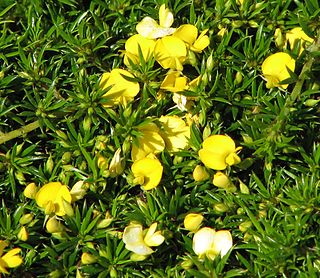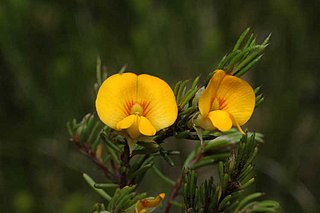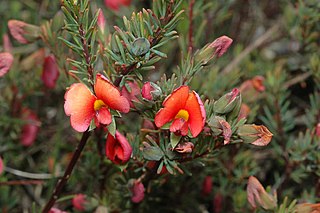
Pultenaea juniperina, commonly known as prickly bush-pea or prickly beauty is a species of flowering plant in the family Fabaceae and is endemic to south-eastern Australia. It is an erect, spiky shrub with hairy stems, linear to narrow elliptic leaves with stipules at the base, and yellow-orange and red flowers.

Pultenaea pedunculata, commonly known as matted bush-pea, is a species of flowering plant in the family Fabaceae and is endemic to south-eastern Australia. It is a prostrate, densely matted shrub with softly-hairy branches that often form roots, narrow elliptic leaves, and bright yellow and brick-red flowers.

Pultenaea densifolia, commonly known as dense-leaved bush-pea, is a species of flowering plant in the family Fabaceae and is endemic to southern continental Australia. It is a spreading or low-lying shrub with broadly egg-shaped, down-curved leaves and clusters of purple or yellow, red and purple flowers.

Pultenaea canaliculata, commonly known as coast bush-pea, is a species of flowering plant in the family Fabaceae and is endemic to coastal areas of southern continental Australia. It is an rigid, spreading shrub with hairy, cylindrical leaves, and yellow and crimson flowers.

Pultenaea cuneata is a species of flowering plant in the family Fabaceae and is endemic to eastern Australia. It is an erect shrub with triangular to egg-shaped leaves with the narrower end towards the base, and groups of yellow to orange and red to purple flowers.

Pultenaea daltonii, commonly known as hoary bush-pea, is a species of flowering plant in the family Fabaceae and is endemic to western Victoria, Australia. It is a spreading shrub with cylindrical leaves, grooved on the upper surface, and clusters of yellow flowers with red markings.

Pultenaea dargilensis is a species of flowering plant in the family Fabaceae and is endemic to a small area in central Victoria, Australia. It is a leaning or low-lying shrub with narrow elliptic to lance-shaped leaves and yellow flowers usually arranged singly on the ends of branchlets.

Pultenaea fasciculata, commonly known as alpine bush-pea or bundled bush-pea is a species of flowering plant in the family Fabaceae and is endemic to south-eastern Australia. It is a small prostrate or low-lying shrub with cylindrical leaves and yellow to orange-coloured flowers arranged singly or in small groups near the ends of branchlets.

Pultenaea foliolosa, commonly known as the small-leaf bush-pea, is a species of flowering plant in the family Fabaceae and is endemic to eastern Australia. It is an erect to low-lying shrub with elliptic to oblong leaves that are concave on the upper surface, and yellow to orange and reddish-brown flowers.

Pultenaea graveolens, commonly known as scented bush-pea, is a species of flowering plant in the family Fabaceae and is endemic to Victoria, Australia. It is a strongly scented shrub with hairy stems, egg-shaped leaves with boat-shaped stipules at the base, and flowers that are mostly yellow.

Pultenaea hispidula, commonly known as rusty bush-pea, is a species of flowering plant in the family Fabaceae and is endemic to south-eastern continental Australia. It is an erect, spreading shrub with many drooping branches, oblong to egg-shaped leaves with the narrower end towards the base, and yellow to pale orange and red flowers.
Pultenaea lapidosa is a species of flowering plant in the family Fabaceae and is endemic to south-eastern Australia. It is an erect to low-lying shrub with linear to narrow elliptic leaves and deep orange and dark red flowers.
Pultenaea maidenii, commonly known as Maiden's bush-pea, is an extinct species of flowering plant in the family Fabaceae and was endemic to Victoria, Australia. It was an erect shrub with egg-shaped leaves with the narrower end towards the base, and pea-shaped flowers.

Pultenaea myrtoides is a species of flowering plant in the family Fabaceae and is endemic to eastern Australia. It is an erect shrub with egg-shaped leaves with the narrower end towards the base, pea-like flowers and flattened fruit.

Pultenaea petiolaris, commonly known as woolly bush-pea, is a species of flowering plant in the family Fabaceae and is endemic to eastern Australia. It is a low-lying shrub with linear leaves, pea-like flowers and flattened fruit.
Pultenaea sericea, commonly known as chaffy bush-pea, is a species of flowering plant in the family Fabaceae and is endemic to south-eastern Australia. It is a small, straggling shrub with hairy branches, elliptic to linear leaves, and yellow and red to purple, pea-like flowers.

Gompholobium uncinatum, commonly known as red wedge pea, is a species of flowering plant in the family Fabaceae and is endemic to eastern Australia. It is a small, low-lying shrub with trifoliate leaves, the leaflets linear to narrow lance-shaped, and red, or orange-red and yellow-green, pea-like flowers.
Pultenaea victoriensis is a species of flowering plant in the family Fabaceae and is endemic to a restricted area of Victoria, Australia. It is a shrub with hairy young stems, wedge-shaped to oblong leaves with a notched tip, and yellow and dark red, pea-like flowers.
Pultenaea indira is a species of flowering plant in the family Fabaceae and is endemic to the south-west of Western Australia. It is an erect or low-lying shrub with plate-like or fissured bark near the base, densely hairy stems above, linear to lance-shaped leaves with the narrower end towards the base, and yellow, red and maroon flowers.

Spyridium bifidum, commonly known as forked spyridium, is a species of flowering plant in the family Rhamnaceae and is endemic to South Australia. It is an erect shrub with densely softly-hairy young stems, wedge-shaped to linear leaves sometimes with a two-lobed tip, and densely woolly heads of white-velvety flowers.















